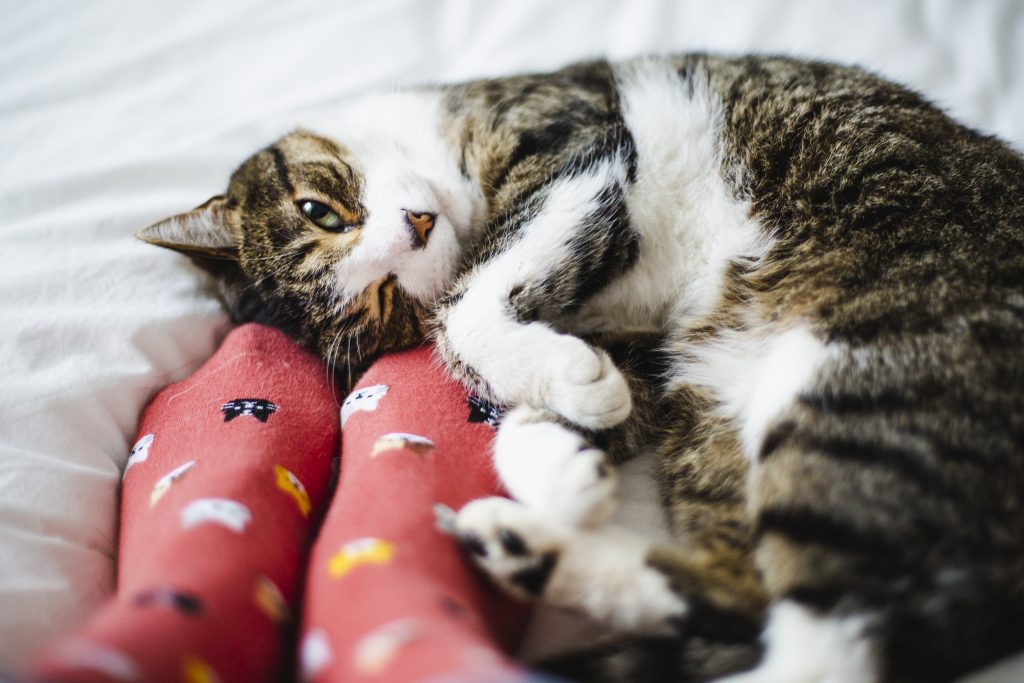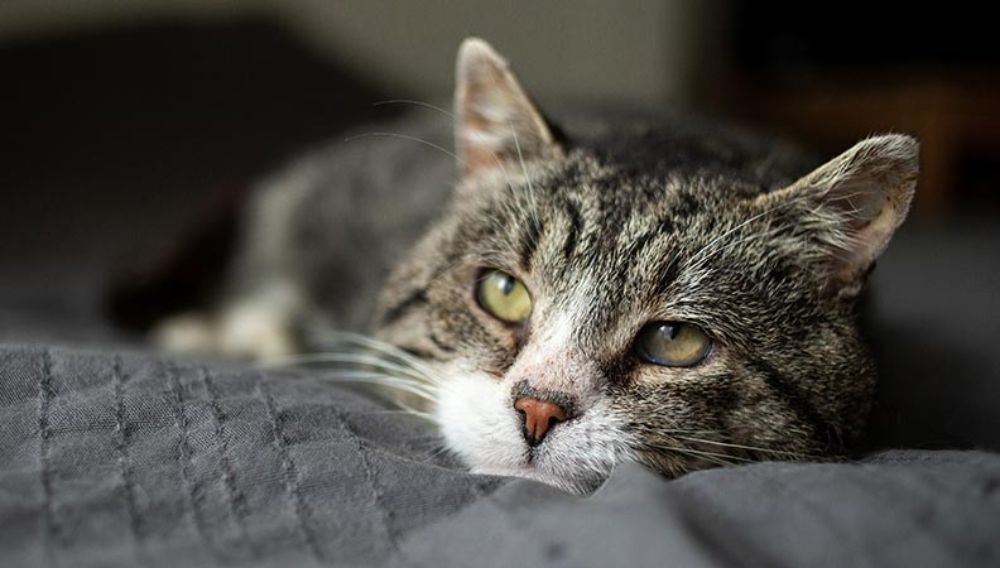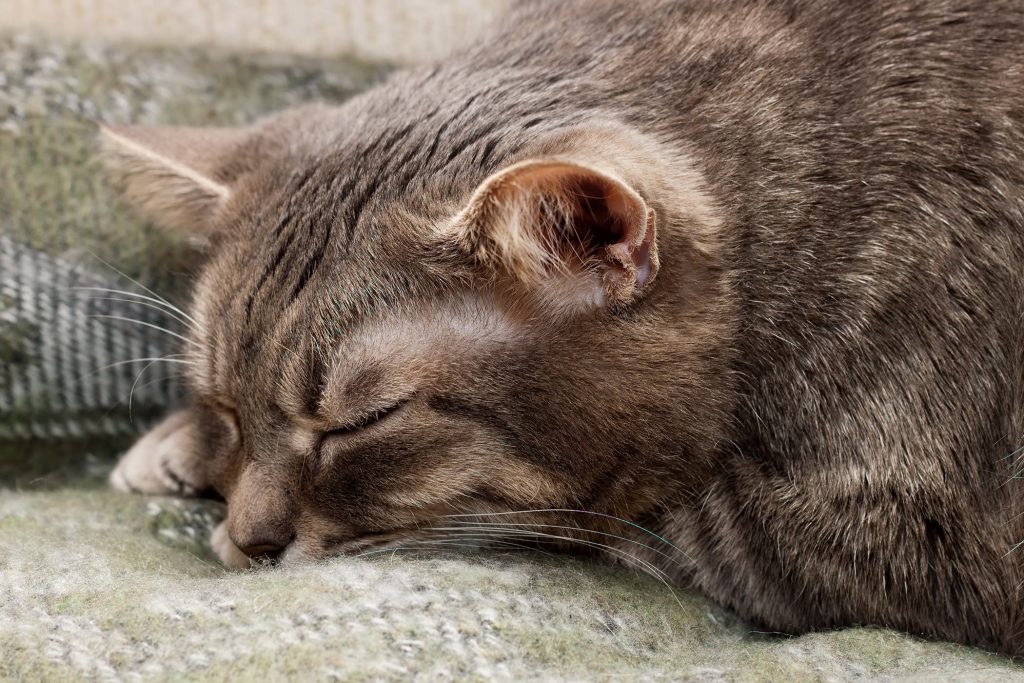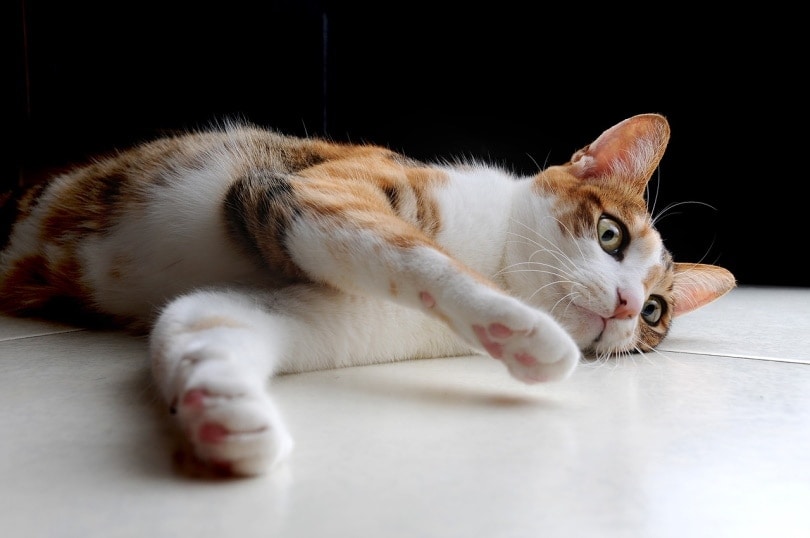Table of Contents
Disorientation in cats
Cats normally have excellent orientation. Their location memory is well developed, meaning they can easily return home when traveling longer distances. If a cat appears disoriented , certain behavior indicates an illness. Older cat find their way around their environme5nt more slowly. For example, you suffer from cognitive dysfunction. If the cat runs in circles disoriented, the behavior may be the result of a stroke. High blood pressure is another possible cause of the house cat’s altered perception.

Why do cats lose their orientation?
If your velvet paw loses its orientation, you will quickly recognize this by cat behavior. For example, the cat runs in circles. Her behavior further confuses her. You notice that your house cat stumbles or sways.
If you notice uncoordinated running around the apartment or in circles, you interpret the behavior as a loss of orientation. In some cases it remains a temporary problem. For example, it occurs if your cat suffers from poisoning. The toxins penetrate into the four-legged friend’s blood and thus into the brain. The synapses react more slowly.
In this case, your cat may move sluggishly or sway. The animals often run into objects and meow more frequently. In cats, disorientation leads to changed behavior. The velvet paws appear more anxious and react aggressively more quickly.
Dementia in cats leads to orientation
Another reason for the velvet paw’s lack of orientation is cognitive dysfunction. This is a dementia that mainly occurs in old age. As with all mammals, cats are predisposed to neurological dysfunction. As the owner, you hardly recognize the first signs. Only in an advanced stage does your four-legged friend change its behavior significantly. The cat makes more noise and meows for a longer period of time.
She walks around her territory disoriented. This means: You don’t recognize any destination when they walk. The cat often runs in circles. House cats suffering from dementia appear restless. They rest less often. Instead, they are constantly in motion. Her gait seems dizzy. In addition, the cat moves from one place to the next seemingly pointlessly. Incorrect perception is one of the typical signs of early dementia in cats.

Your four-legged friend runs through all the rooms but can’t find a destination. Walking around in circles is becoming more common. Furthermore, the velvet paw misjudges distances. For example, if the animal tries to jump onto the window sill, it falls down. The high-up sleeping place is also increasingly becoming an unattainable goal. This is why you notice that your cat is increasingly looking for places on the floor. During this search, the animal also appears to be disoriented. Other features of cognitive dysfunction include:
- increased anxiety,
- frequent meowing,
- forgetting loot or toys,
- poorer grooming
- as well as depression.
In cats, depression manifests itself in the refusal of food and a greater need for sleep. Another sign of dementia is incontinence. The cat forgets where its litter box is. At first she often does her business outside. As the vestibular disease progresses, the cat is walking while urinating all over the apartment. She also distributes the feces in several rooms. If your four-legged friend appears disoriented, it is best to set up several litter boxes.
It is also advisable to remove the majority of chairs or tables from the center of the room. Demented cats also run in circles. This leads to a disruption of the sense of balance. In some cases, turning may be followed by running against various objects.
To ensure that your animal doesn’t get injured, ensure there is as much free space as possible. The loss of orientation results in the loss of their rank in a multi-cat household. You quickly realize that the other house cats are driving the affected animal away from the food bowl. They also challenge the disoriented cat. In other cases, other cats treat the sick cat like a kitten. This means that the animal no longer has a rank, but is outside the “pecking order”.
When it comes to cognitive dysfunction, there is usually no uniform clinical signs. It normally occurs from the age of ten onwards. This does not affect all cats, but only animals that have a corresponding genetic predisposition. If your four-legged friend appears disorientated, there may be other potential reasons.
A stroke causes disorientation
Another reason for the cat’s lack of orientation is a stroke. A hemorrhage in the brain or brain tumor damages the cat’s normal coordination. For example, she moves very slowly. The high blood pressure that occurs also leads to blindness in the animal. This causes the retina to detach. The velvet paw temporarily loses its eyesight. Nevertheless, the pupils react to light, so owners often overlook the symptoms.
If blindness results from a retinal detachment, doctors will restore the cat’s vision. Medication prevents high blood pressure. This eliminates the excess fluid in the cat’s eye that penetrates between the layers of the retina. Medicines ensure that it settles down again. In this way, the cat regains its vision. Before that, staggering and aimless walking appear to be signs of blindness.

If the cat runs in circles, there is an injury to the vestibule, for example. It affects the cat’s sense of balance. There is also the possibility of damage to the cerebellum or brainstem. In both cases, the affected four-legged friend suffers from significant balance disorders. If you notice such behavior in your cat, consult the vet immediately. Quick help protects the house cat from permanent damage.
A cat to walk in round quickly loses its place in a multi-cat household. The other cats often fight over her food or treat her like a kitten. Research into the causes is therefore given high priority. If the cat runs in round, it is suffering from a balance disorder, for example. This results from poisoning, inflammation of the vestibule or blindness.
Why is my feline circling? – The possible causes
It is comparatively common to see dogs with idiopathic vestibular disease and in a wide variety of situations. Sometimes the reasons are fear and discomfort, but of course it can also happen out of joy or excitement.
With cats, however, things look a little different. The animals usually don’t actually walk in circles, which makes this behavior somewhat worrying in many cases.
The first and most common reason, in short, is an existing lack of orientation. However, a distinction must be made here again as to how this comes about. It’s not without reason that the animal is simply disoriented.
Since, like us humans, the balance organ of domestic tigers is located in the ear, an ear infection can be the reason why your kitty circling.
Since such an infection can affect not only the eardrum, but also the parts of the ear that ensure balance and orientation, this behavior is not unusual. In itself that wouldn’t be too bad, it’s just important that you have the infection treated by a vet immediately, otherwise permanent damage could occur.

Poisoning as a reason for walking around strangely
Poisoning can also be a reason for a cat to run in circles. Unfortunately, it can never be ruled out that if the house cat goes outside, it won’t eat something poisonous.
The poisoning does not necessarily have to be fatal at that point, but it can damage the organs and even the brain.
Disorientation in the event of poisoning is therefore not uncommon. This can lead to the cat suddenly starting to run in circles in confusion. If you observe this behavior very suddenly, the alarm bells should ring immediately. This is especially true with a young cat. You should go straight to the vet or even an animal clinic to keep the damage as small as possible.
Cat always runs in circles – positive reasons?
It is very important to look at the cat’s behavior as such and in what situation the animal runs in circles. In addition to many health problems, the animals also like to do this when they want to lie down.
For example, they kick the blanket into shape with their paws and in this way directly mark their territory.
This behavior is also often seen in dogs. However, there are no other real reasons why your cat should walk in circles. However, it is also important to note that, just like humans, animals have different character traits.
So it may well be that your cat likes to run in circles every now and then out of habit. Although this is highly unusual, it is not impossible. It only becomes worrying when the animal suddenly starts doing this, because then you notice that something has changed in its behavior.
As already mentioned, it is really important to act quickly and explain to the treating veterinarian as precisely as possible when and in what situation you observed this behavior.
Treatment for disorientation in cats
Disorientation in cats can be caused by various underlying issues, including medical conditions, neurological problems, or environmental factors. If you notice signs of disorientation in your cat, it’s crucial to consult with a veterinarian for a proper diagnosis and appropriate treatment. Here are some general steps and considerations:
- Consult a Veterinarian:
Schedule a visit to the veterinarian as soon as possible. A thorough examination can help identify the underlying cause of disorientation, whether it’s due to an illness, injury, or other factors. - Diagnostic Tests:
The veterinarian may recommend diagnostic tests such as bloodwork, urinalysis, imaging (X-rays, ultrasound, or MRI), or other specialized tests to pinpoint the cause of disorientation. - Treatment of Underlying Cause:
The treatment will depend on the specific cause identified. For example: - Fluid Therapy and Supportive Care:
If your cat is dehydrated or experiencing other systemic issues, the veterinarian may administer fluids and provide supportive care. - Medications:
In some cases, medications may be prescribed to address symptoms or manage specific conditions contributing to disorientation. - Hospitalization:
In severe cases or when the cause of disorientation requires intensive care, the veterinarian may recommend hospitalization for monitoring and treatment. - Follow-Up Visits
Regular follow-up visits with the veterinarian may be necessary to monitor progress, adjust medications, or address any new developments. - Provide a Comfortable Environment
Create a quiet and comfortable environment for your cat at home. Minimize stressors and ensure they have access to their litter box, food, and water. - Observe Behavior Changes:
Keep a close eye on your cat’s behavior and note any changes. Report any new symptoms or concerns to your veterinarian promptly. - Nutrition:
Ensure your cat is receiving a balanced and nutritious diet. In some cases, dietary changes or supplements may be recommended.
If an infection is present, the veterinarian may prescribe antibiotics.
If there are neurological issues, medications or other treatments may be recommended.
Environmental factors contributing to stress or anxiety may require behavioral interventions or changes in the cat’s surroundings.
It’s important to emphasize that disorientation is a symptom rather than a diagnosis. Identifying and treating the underlying cause is essential for effective management. Early intervention can improve the chances of a positive outcome, so seeking veterinary care promptly is crucial.

Ataxia in cats – Tips and information
The cat staggers, has an unsteady gait, problems with balance and appears almost “drunk”- all of these are signs of ataxia. In this article we will look at what exactly ataxia in cats is, what the symptoms and causes are, how it is diagnosed and what to look out for in a cat with ataxia.
What is ataxia in cats?
The word “ataxia” comes from the Greek (ataxia = disorder) and describes movement disorders that have different causes and can occur at any age. In a cat with so-called wobbler syndrome, i.e. a cat with ataxia, the brain is unable to properly control body movements. The result is uncoordinated movement sequences.
Ataxia itself is not the causative disease, but rather a symptom. This means that the coordination problems are caused by another cause. Depending on the type of disease, other symptoms may occur in addition to ataxia.
What are the symptoms of ataxia in cats?
A cat with ataxia usually shows a range of symptoms that can vary in severity. Most affect the cat’s coordination of movements, although breathing difficulties such as coughing can also occur. It should be mentioned here that Sneezing in cats is not a symptom of ataxia, but is a sign of diseases such as cat flu can be. If you suspect your cat may be suffering from ataxia, you should look out for the following signs:
- Uncontrolled movements
- Shaky and wide gait
- Unsteady footing
- Tip over
- Shaking of the head
- Trembling eyes
- High sensitivity to noise
- Disturbed perception
- Difficulty breathing, e.g. coughing
What are the causes of ataxia in cats?
As already stated, ataxia is not a diagnosis, but a symptom. The causes can often be traced back to damage to the central nervous system (CNS), but can also be genetic or triggered by accidents. The most common triggers for ataxia in cats are:
- Infections (especially caused by the so-called panleukopenia, also known as cat disease, which is caused by the kitty parvovirus)
- Genetic defects (lysosomal storage diseases or abiotrophy)
- Accidents (bone fractures and damage to the CNS)
- Malnutrition (deficiency of thiamine)
- Malformations (cerebellar hypoplasia or congenital myasthenic syndrome (CMS) for rare cat breeds)
How is ataxia diagnosed in cats?
If you suspect that your kitty might be suffering from ataxia, it is important to have him examined by a veterinarian so that he or she can get to the bottom of the cause and initiate proper treatment.
To do this, he will first ask you a series of questions about your pet, such as previous illnesses, accidents and feeding. He will then examine your cat thoroughly, take blood, urine and/or fecal samples if necessary and arrange for further examinations. These include CT, MRI and X-rays, but also measurements of brain and muscle activity (electroencephalography, electromyography, cerebrospinal fluid puncture).

What types of ataxia are there in cats?
Depending on the cause of ataxia, it is divided into different types. Below we take a closer look at the three main types:
Cerebellar ataxia
The most common form is cerebellar ataxia, in which the cerebellum is damaged. This is the part of the brain that is responsible for fine motor skills and controls the musculoskeletal system. Many cats with cerebellar ataxia become ill in utero when the mother suffers from kitty disease and as a result the kitten’s brain cannot develop properly. However, tumors, accidents and poisoning can also result in cerebellar ataxia later in a cat’s life.
This type of ataxia causes uncoordinated movements of the limbs and head, as well as head tremors. In addition, cats with cerebellar ataxia usually take excessively large steps when running.
Sensory ataxia
Sensory ataxia is caused by injury and compression of the spinal cord, although joint diseases and spinal deformities can also lead to this type of ataxia.
Common signs of sensory ataxia are uncoordinated movements because the cat essentially doesn’t know where its legs are in space. In addition, a wide position of the front and hind legs indicates this type of ataxia.
Vestibular ataxia
Vestibular ataxia refers to damage to the organ of balance ( vestibular system), which is located in the inner ear. Potential reason of vestibular ataxia include an inner ear infection or a disease of the nerves between the inner ear and the brain. An underactive thyroid can also lead to what is known as vestibular syndrome.
The typical symptoms of this form of ataxia include holding the head crooked, eye tremors, incoordination when walking and falling over. Vomiting can also occur as a result of the dizziness. Cats with central vestibular ataxia, i.e. those in which the brain stem is affected, are also often very quiet and sleepy.
How is ataxia in cats treated?
Treatment for ataxia depends on the cause. If this can be treated, this should be done first. In the case of cancer, the tumors should be removed or thiamine should be administered if the ataxia is caused by a corresponding deficiency.
If the ataxia is caused by an untreatable illness, it cannot be treated causally with antibiotic, but if symptoms such as nausea occur, appropriate medication can be administered to increase the cat’s quality of life. Physiotherapy can also help to improve the four-legged friend’s coordination skills.
Cats who have ataxia from birth often do not require further treatment because they are used to the lack of balance and coordination from an early age and have learned to live with it. However, you should ensure a safe environment to prevent the cat from falling from a height and injuring itself.
Is ataxia in cats curable?
Whether ataxia in cats can be cured depends entirely on the primary disease. If the underlying disease is curable, detected early and treated quickly, then the feline might well recover from ataxia. This can be the case, for example, with an ear infection. Unfortunately, many diseases that can cause ataxia cannot be completely cured. However, therapy can help relieve the symptoms of ataxia.
What is the life expectancy of a cat with ataxia?
How ataxia affects the cat’s life expectancy depends primarily on the type of disease that causes it. If there are no other illnesses, the cat’s life expectancy is usually not affected any further. Another good news is that with the right support, the cat with ataxia can live a relatively normal life.
Practical tips for living with a cat with ataxia
Fortunately, ataxia is a disorder that cats can largely live with. To make everyday life easier for your cat with ataxia and to ensure that it is in an environment tailored to its needs, we have put together some practical tips for you below.
Keep them away from stairs, open windows, and ledges
If the cat staggers easily and has an unsteady gait, anything that it can fall off of is a danger. Make sure that it cannot get close to stairs, open windows, etc. to avoid falling injured.
Don’t let the cat roam free outside
The outside world is extremely dangerous for a cat suffering from ataxia, as they find opportunities to climb everywhere – and can injure themselves there. If you still want to let your cat outside from time to time, you can get him an outdoor enclosure.
Avoid slippery floors
The house tiger can easily slip and fall on smooth floors such as laminate or tiles. Carpets are therefore more suitable as they give the cat with ataxia more support and stability when walking.
Find the right food nap
Many cats with ataxia find it difficult to lower their heads to the ground because they sway in this position. An elevated feeding bowl can help here, so the cat doesn’t have to lower its head, or barely has to.
Help her use the litter box
Litter boxes with high walls are particularly suitable for ataxia, as the cat can lean against the wall while doing its business and not stagger around in the litter box and possibly even tip over.
Provide an alternative to the scratching post
Due to balance problems, a conventional scratching post is rather unsuitable for an ataxia cat. Look for a low alternative, perhaps made of corrugated cardboard, that the cat can use while sitting or lying down.
Support your cat with physical therapy
You can help your cat improve his motor skills and build muscles by doing physical therapy exercises with him. First, seek advice from an animal physiotherapist or veterinary. He can give you precise instructions on the exercises and tailor them individually to your pet.
FAQs
Q: What are the common signs of a kitty circling disoriented?
A: The common signs include the cat walking around in circles, acting disoriented, and being unable to walk in a straight line.
Q: When should I be concerned about my kitty circling ?
A: If your cat suddenly starts walking in circles like it’s disoriented, it’s time to consult a vet as it may indicate a serious health issue.
Q: What are the potential reason of a kitty circling ?
A: The causes can range from idiopathic vestibular disease to a brain tumor or head trauma. It’s essential to seek veterinary advice to diagnose the underlying issue.
Q: How can I help my disoriented kitty circling ?
A: If you notice your kitty circling and seeming disoriented, it’s crucial to observe your cat closely and seek veterinary assistance for a proper treatment plan.
Q: Are there any specific symptoms associated with a cat walking in circles in a disoriented manner?
A: Symptoms may include a head tilt, abnormal eye movement, and other neurologic signs, which need to
Q: What should I do if my old cat is suddenly walking in circles?
A: If your old cat seems disoriented and starts walking in circles, it’s important to consult a vet promptly as it could indicate various potential issues, including cognitive dysfunction.
Q: Can stress cause a cat to walk in circles and act disoriented?
A: Yes, stress can be a contributing factor, but it’s essential to rule out other serious health conditions like vestibular disorders or brain injury that may cause similar symptoms.
Q: Are there any specific treatments for feline circling due to vestibular disease?
A: The treatment plan may vary based on the underlying cause. Your vet may suggest medications, therapy, or other interventions depending on the diagnosis.
Q: Is it common for senior cats to walk in circles and seem disoriented?
A: Yes, senior cats may exhibit disorientation and walk in circles due to various age-related issues, so it’s crucial to have them evaluated by a veterinarian to determine the cause.
Q: What should I do if my cat is walking in circles and appears confused?
A: If your cat seems confused and is walking in a circle, it’s important to seek veterinary advice promptly to identify the cause of your cat’s behavior and initiate appropriate care.